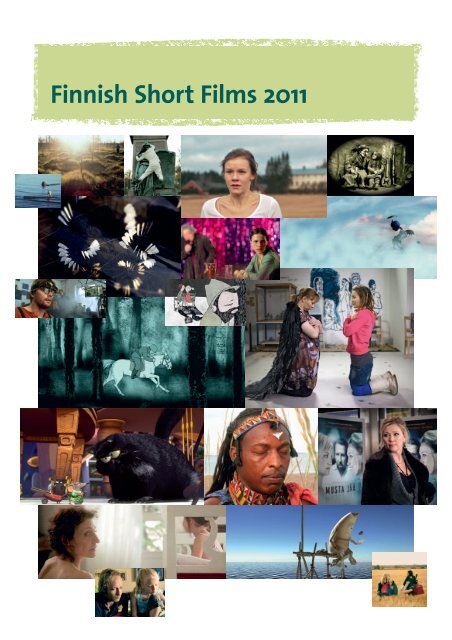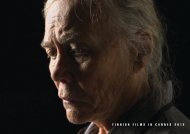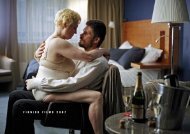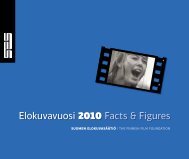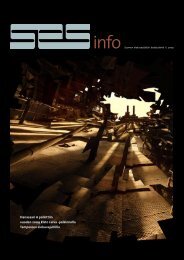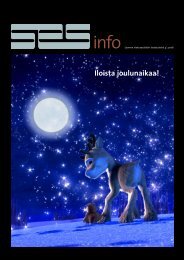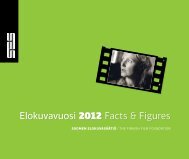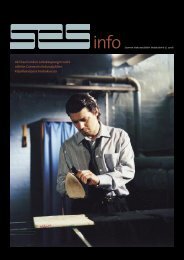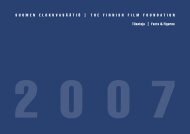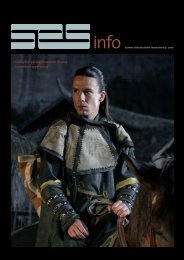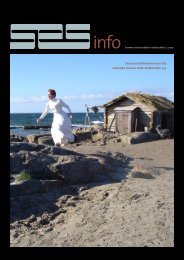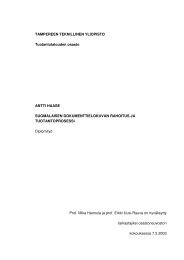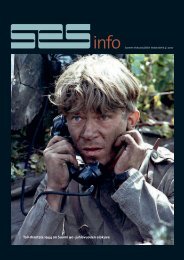2 Finnish Short Films 2011
2 Finnish Short Films 2011
2 Finnish Short Films 2011
Create successful ePaper yourself
Turn your PDF publications into a flip-book with our unique Google optimized e-Paper software.
<strong>Finnish</strong> <strong>Short</strong> <strong>Films</strong> <strong>2011</strong>
Contents<br />
<strong>Finnish</strong> <strong>Short</strong> <strong>Films</strong> and Festival Success<br />
<strong>Finnish</strong> short films and festival success 2<br />
Interview with film commissionner Joona Louhivuori 3<br />
<strong>Finnish</strong> short film makers form a united front<br />
to face challenges 3<br />
Interview with director Kari Juusonen 4<br />
Interview with director Saara Cantell 5<br />
Making of the Death of an Insect 7<br />
<strong>Short</strong> fiction<br />
The Annunciation 8<br />
L’Artiste 8<br />
Burungo 9<br />
Elma & Liisa 10<br />
Georg and Lydia 11<br />
Largo 12<br />
Liv 12<br />
Meal with a Deal 13<br />
The Painting Sellers 14<br />
A Perfect Day 14<br />
The Variation 17<br />
<strong>Short</strong> Animations<br />
Booris the Råt Mends His Ways 8<br />
Edith 10<br />
Faruza 10<br />
Mangel 12<br />
Papa’s Boy 14<br />
Summer in Helsinki 16<br />
The Tongueling 17<br />
Ö 17<br />
<strong>Short</strong> documentaries<br />
Could You Love 9<br />
The Death of an Insect 9<br />
How to Pick Berries 11<br />
Inhale 11<br />
Minispectacles 1–3 13<br />
Old Man and the Lady 13<br />
Ruins of the Gaze 15<br />
Soul Catcher 15<br />
Tabula Rasa 16<br />
A Tall Man 16<br />
Contact information 18<br />
Coming up in <strong>2011</strong>:<br />
<strong>Finnish</strong> feature films 19<br />
This magazine is in two parts. This part is devoted<br />
to new <strong>Finnish</strong> short films. When you turn the<br />
magazine upside down, you will find the part devoted<br />
to new documentaries. There you will also<br />
find information on documentary films that are<br />
longer than 30 minutes.<br />
More facts and figures about <strong>Finnish</strong> documentary<br />
films are available at our website:<br />
www.ses.fi – Statistics<br />
V<br />
Current Situation<br />
Despite limited resources, <strong>Finnish</strong> short<br />
films are doing well at international festivals.<br />
The short films that the <strong>Finnish</strong><br />
Film Foundation has been promoting internationally<br />
have received a notable amount of visibility<br />
during 2010 at several internationally significant<br />
film festivals and at other film events. Compared<br />
to 2009, the volume of exported films has<br />
increased, specifically in the genres of short and<br />
documentary films. The successful cooperation of<br />
AVEK (The Promotion Centre for Audiovisual<br />
Culture) and the <strong>Finnish</strong> Film Foundation to advance<br />
the cultural export of short and documentary<br />
films has guaranteed an international audience<br />
for a genre that in Finland remains marginal. The<br />
audiences at international film festivals are a significant<br />
addition to the annual number of viewers<br />
of <strong>Finnish</strong> films.<br />
In 2010, the <strong>Finnish</strong> films that were screened<br />
the most at international festivals were Iris Olsson’s<br />
praiseworthy short documentary, Between<br />
Dreams, Hamy Ramezan’s award-winning short<br />
film, Over the Fence, Kaisa Penttilä’s actionpacked<br />
animated short film, The Egg Race, Jouni<br />
Hokkanen’s Kinbaku – Art of Bondage, an introduction<br />
to the Japanese art form, and Hannes<br />
Vartiainen and Pekka Veikkolainen’s Hanasaari<br />
A and The Death of an Insect. Another sign of<br />
a successful year is that in early 2010 the world’s<br />
most important short film festival in Clermont-<br />
Ferrand, France, screened a record number of<br />
<strong>Finnish</strong> short films. Also other world-class festivals,<br />
especially Sundance and Berlin, have in recent<br />
years screened several <strong>Finnish</strong> short films.<br />
Case of Hanasaari A<br />
For the past two years, the <strong>Finnish</strong> short film that<br />
has gained the most attention abroad has been<br />
Hanasaari A, directed by Hannes Vartiainen and<br />
Pekka Veikkolainen. The story of the destruction<br />
of Helsinki’s old coal plant and the irreversible<br />
change in the cityscape received the Risto Jarva<br />
Award at the Tampere Film Festival in March<br />
2009. Qualifying for the international competition<br />
was a major accomplishment for the young film<br />
makers and the 10 000 euros in prize money gave<br />
them several extra months to develop their next<br />
works.<br />
Despite the success in Tampere, Hanasaari A’s<br />
international breakthrough didn’t happen overnight.<br />
The doors of important film festivals began<br />
to gradually open in the summer and autumn of<br />
2009. During autumn 2009, the film was seen,<br />
among other places, at the <strong>Short</strong> Film Festival in<br />
Drama, Greece, the Nordisk Panorama in Reykjavik,<br />
Festival du Nouveau Cinema in Montreal, the<br />
Lübeck Nordic Film Days, and the Plus Camerimage<br />
in Lodz, a festival that emphasises artistic<br />
merits when making its film selections.<br />
Festivals have provided useful networking opportunities<br />
for Vartiainen and Veikkolainen and<br />
they have met many key people on the film festival<br />
circuit as well as other film makers. According<br />
to the pair, it has been a rewarding experience to<br />
see their film with different kinds of audiences.<br />
“It’s great that the <strong>Finnish</strong> Film Foundation and<br />
AVEK sponsor the festival trips. Then it’s pretty<br />
much up to the film makers themselves how they<br />
take advantage of the opportunities that are given<br />
to them. It’s been a delightful surprise that our<br />
film has found an audience and been in demand<br />
all around the world. We didn’t dare expect anything<br />
beforehand. Our festival tour has been a<br />
year and a half long series of happy surprises,”<br />
Vartiainen and Veikkolainen summarise.<br />
From Clermont-Ferrand to Hong Kong<br />
In the past two years, Hanasaari A has been<br />
screened at over 50 international film festivals.<br />
This is partly due to the fact that the film’s form<br />
has enabled it to be selected for both documentary<br />
and animated film festivals as well as for festivals<br />
devoted to experimental films. In 2010, the<br />
most significant festivals Hanasaari A was seen at<br />
were the Clermont-Ferrand short film festival in<br />
France, the Full Frame Documentary Film Festival<br />
in the United States, and the internationally<br />
regarded Hong Kong Film Festival, where the<br />
film won the Grand Prix for Best <strong>Short</strong> Film. It<br />
has also received honourable mentions in Germany<br />
and Spain. For Vartiainen and Veikkolainen, the<br />
Clermont-Ferrand festival was one of the most<br />
memorable.<br />
“Clermont-Ferrand is in a class of its own as far<br />
as festivals for short films go. I doubt there’s another<br />
festival where the early afternoon screenings<br />
of experimental films are sold out,” Vartiainen and<br />
Veikkolainen marvel.<br />
The directors of Hanasaari A have broadened<br />
their knowledge of films by open-mindedly<br />
watching a lot of new films by other film makers.<br />
When festival schedules have permitted it,<br />
the pair have introduced their film before each<br />
showing. “It’s been fun talking to people after the<br />
showings. Jury members who have voted for Hanasaari<br />
A have come over at festival clubs and airports<br />
to explain why we didn’t win,” the pair say<br />
with a laugh.<br />
The director duo’s newest short film, The Death<br />
of an Insect, had its international premiere at the<br />
Venice Film Festival in September. During this<br />
past autumn, it was seen at almost twenty leading<br />
short film and documentary festivals. Both men<br />
have once again been enthusiastic guests at many<br />
of the festivals.<br />
“The film has aroused interest all over the<br />
world. We did decide right away that we wouldn’t<br />
make another film like Hanasaari A, but rather<br />
something different.”<br />
Clermont-Ferrand <strong>2011</strong><br />
This year, the Clermont-Ferrand short film festival’s<br />
International Competition will feature<br />
Markku Heikkinen’s short documentary Old<br />
Man and the Lady. The Lab Competition, which<br />
is devoted to experimental film, will feature Elli<br />
Vuorinen’s animated film Tongueling and Hannes<br />
Vartiainen and Pekka Veikkolainen’s The Death<br />
of an Insect.<br />
Otto Suuronen<br />
2 <strong>Finnish</strong> <strong>Short</strong> <strong>Films</strong> <strong>2011</strong>
Joona Louhivuori –<br />
new film comissioner for short films<br />
Milla von Konow<br />
Joona Louhivuori<br />
Joona Louhivuori started his work<br />
as the film comissioner responsible<br />
for short films at the <strong>Finnish</strong> Film<br />
Foundation in autumn 2010. Louhivuori<br />
has studied film at the Aalto University<br />
School of Art and Design (formerly the<br />
University of Art and Design Helsinki)<br />
and worked as a freelance film editor for<br />
ten years. He has extensive experience in<br />
editing TV drama, trailers, commercials<br />
and music videos, a background that<br />
benefits him in his new position in a<br />
very concrete way.<br />
“I think my background as an editor<br />
is useful in my job as a film comissioner<br />
because, in both roles, you look at<br />
a film that’s being made from a certain<br />
distance, more so than the director. In<br />
both roles, you have to keep in mind<br />
that short films are a large whole where<br />
details rarely affect the work’s quality<br />
as much as the chosen viewpoint<br />
or the atmosphere being emphasised”,<br />
says Louhivuori, comparing his two job<br />
descriptions. He adds that, both as editor<br />
and on the funding side, he has to<br />
consider a film’s meaning in relation to<br />
the world around it, namely whether the<br />
story is treated in a way that has been<br />
done before or whether the subject is a<br />
current one.<br />
Perhaps the biggest difference between<br />
the two job descriptions in<br />
Louhivuori’s view is that, as an editor,<br />
he can become immersed in one work<br />
for months. As a film comissioner,<br />
on the other hand, he deals with numerous<br />
projects simultaneously and<br />
non-stop, which has been extremely<br />
refreshing.<br />
Has the altered point of view<br />
changed him as a film viewer “I<br />
probably watch movies the same way<br />
as before. I don’t think anything has<br />
changed. As an editor, I’ve always<br />
tried to see things from the moviegoer’s<br />
point of view. In other words, I’m<br />
always trying to maintain the viewing<br />
experience of someone who has seen<br />
the film for the first time.”<br />
Joona Louhivuori’s own goal is to<br />
help make funding decisions that enable<br />
the best projects to be realised<br />
and the most interesting filmmakers<br />
to keep working. “In the best case, it<br />
could raise the level of <strong>Finnish</strong> film<br />
narrative and in such a way that it<br />
would reach domestic audiences, in<br />
particular, even better than before”,<br />
Louhivuori sums up.<br />
Tytti Rantanen<br />
<strong>Finnish</strong> short film makers form<br />
a united front to face challenges<br />
<strong>Finnish</strong> short films entered the<br />
new decade in a challenging<br />
situation, but despite this,<br />
their high quality has brought international<br />
attention and success. Several<br />
films have been actively touring different<br />
festivals, including the Berlin,<br />
Cannes and Venice film festivals, the<br />
most prestigious events of their kind,<br />
the Clermont-Ferrand International<br />
<strong>Short</strong> Film Festival and the Nordisk<br />
Panorama short and documentary film<br />
festival, which was held in Norway.<br />
The busiest festival entrants have been<br />
the animation The Egg Race, which took<br />
part in 26 festivals, and the novella<br />
film Over the Fence, which participated<br />
in 29 festivals. <strong>Finnish</strong> short films also<br />
managed to grab some awards, as Juho<br />
Kuosmanen’s The Painting Sellers won<br />
the main prize in the Cinéfondation<br />
Series at Cannes.<br />
The <strong>Finnish</strong> Film Foundation and<br />
AVEK (The Promotion Centre for<br />
Audiovisual Culture) annually fund<br />
an average of 15 short films. A third<br />
important source of funding is the<br />
<strong>Finnish</strong> Broadcasting Company YLE,<br />
which not only invests funds in <strong>Finnish</strong><br />
short films, but also offers a convenient<br />
channel for showing them to<br />
the public. In fact, <strong>Finnish</strong> short films<br />
have consolidated their position among<br />
YLE’s cultural programmes, being<br />
currently broadcast on two different<br />
channels. In 2009, YLE broadcast a<br />
total of 88 short films, 16 of which<br />
were shown for the first time.<br />
The challenges of the coming<br />
years will come as a result of a radical<br />
change on the production side of<br />
things. As a cost-saving measure, YLE<br />
plans to cut the number of external<br />
programme commissions and its participation<br />
in co-productions. Instead,<br />
the broadcasting company aims to shift<br />
its focus to in-house drama production.<br />
This will naturally raise nervous questions<br />
at small production companies.<br />
However, Sari Volanen, the<br />
producer in charge of short films in<br />
YLE’s co-production team, assures<br />
us that short films will continue to be<br />
produced in the future, even though<br />
there is no general policy concerning<br />
the media through which they will be<br />
broadcast. According to Volanen, YLE<br />
still intends to create good working<br />
relationships with new film-makers<br />
as part of a healthy film culture. Even<br />
amidst uncertainty, forming a united<br />
front is extremely important. YLE, the<br />
<strong>Finnish</strong> Film Foundation and AVEK,<br />
together with directors, producers<br />
and <strong>Finnish</strong> film festivals, are seeking<br />
a sustainable solution to the current<br />
challenges.<br />
In addition to the united front,<br />
more emphasis has to be put on quality.<br />
“The Nordisk Panorama film festival<br />
was just given Oscar status, which<br />
means that the festival’s winner can<br />
Sari Volanen<br />
become an Oscar nominee. Will it take<br />
winning an Oscar for the political circles<br />
in Finland to become interested in<br />
short films In any case, what we need<br />
and want now are even better quality<br />
films and stories”, says Volanen.<br />
Tytti Rantanen<br />
Milla von Konow<br />
<strong>Finnish</strong> <strong>Short</strong> <strong>Films</strong> <strong>2011</strong> 3
Kari Juusonen<br />
Milla von Konow<br />
A rope extending to the heavens controls the Creatures<br />
Kari Juusonen’s animation “Ö” is an evolution story whose characters are protozoans from our planet’s ancient past.<br />
Considered one of Finland’s<br />
leading animators, Kari<br />
Juusonen (born 1967) has<br />
switched techniques from clay animation<br />
to computer animation.<br />
Juusonen’s new 12-minute solo<br />
work is called Ö. Before this Juusonen<br />
had created the short clay animations<br />
Pizza Passionata (2001) and The Birthday<br />
(2004), with the former winning him<br />
the Prix du Jury award at the Cannes<br />
film festival.<br />
He has had a long break since his<br />
last work but he has a good reason for<br />
this. Juusonen has built a house and<br />
worked as a co-director in the feature-length<br />
computer animation Niko<br />
– The Way to the Stars (2008), by the<br />
Anima Vitae animation studio. The<br />
film’s other director was the Danish<br />
Michael Hegner. Distributed to over<br />
one hundred countries, the speedy and<br />
Christmas-themed Niko is one of the<br />
most internationally successful <strong>Finnish</strong><br />
films of all time.<br />
“Ö is a kind of reflective work”, says<br />
Juusonen.<br />
“It’s probably the fact that I’m middle-aged<br />
that creates a slightly introverted<br />
atmosphere sometimes. You can<br />
understand the passage of time in another<br />
way – I’ve tried to make time visible<br />
in the film using ropes that extend<br />
upwards out to the characters.”<br />
As described, the film’s protozoan<br />
creepy-crawly characters are attached<br />
to wire-like ropes that lead up, as if<br />
umbilical cords to the heavens.<br />
One of the creatures rises from the<br />
water onto an island, begins to explore<br />
the world with its limited senses and<br />
tries to fortify the island, but eventually<br />
realises it wants to make contact<br />
and spend time with others. This very<br />
original film seems like a metaphor<br />
for humans trying to find their way.<br />
When you watch Ö, you are reminded<br />
of the way the story is carried and the<br />
infinite savouring of existence that<br />
Pixar boldly displayed in the computer<br />
animation Wall-E.<br />
The imagery of Ö, however, is<br />
the work of one man, created in the<br />
boiler room of the new house built by<br />
Kari Juusonen. At the time of his first<br />
award-winning animation, Juusonen<br />
saw himself very much as a “manual<br />
labourer”, but tools change.<br />
“Initially I made a one-minute clay<br />
animation demo of Ö, but putting the<br />
ropes in proved too difficult. With<br />
computer animation you can make<br />
movement look the way you want it.<br />
The feel here had to be immaterial.”<br />
“The film as a whole, though, is<br />
carefully constructed. I don’t get ideas<br />
for films in my dreams. What is interesting<br />
is the rope, a force that draws<br />
the characters in a certain direction. I<br />
was intrigued by the thought of following<br />
this with the logic of a nature film<br />
that is as pure as possible.”<br />
During the working stage, Juusonen<br />
called the main character ‘Hemppa’<br />
and the other members of his species<br />
‘Creatures’. The film’s creatures, of<br />
course, cannot speak any clearly formed<br />
language. In the preliminary production<br />
information, the central character<br />
was called ‘Adam’.<br />
“After Niko, this short film feels like<br />
it’s a form of self expression. Although<br />
in the best cases, when working on a<br />
feature film, the filmmaker can share<br />
his ideas and even make confessions.”<br />
“I have a long-term plan for my own<br />
film that would be half live, half computer<br />
animation. I think I might make<br />
some kind of a live short film before<br />
that, though”, Juusonen promises.<br />
Niko the Reindeer’s stepfamily<br />
“There are lots of really interesting<br />
<strong>Finnish</strong> short animation makers”, Juusonen<br />
says. Animation training and<br />
the opportunities offered by the industry<br />
are quite a new thing in Finland.<br />
When Juusonen was working on his<br />
debut film, Pizza Passionata, which is a<br />
love mystery taking place in a concrete<br />
suburb, he considered making the animations<br />
in Estonia. But within a dec-<br />
ade, an entire animation industry has<br />
been born in Finland, whose influencers<br />
include Petteri Pasanen, the untiring<br />
ambassador for the Niko project<br />
and the producer of Pizza Passionata.<br />
Now that Ö is finished, Juusonen<br />
has taken on a new job with Anima<br />
Vitae, which is creating a sequel for<br />
the story of Niko the little reindeer.<br />
The sequel is to be released for Christmas<br />
2012 and currently has the working<br />
title ‘N2’. “I’m responsible for<br />
image design and animation again.<br />
My co-director, the Danish charmer<br />
Jørgen Lerdam, will be responsible<br />
for character design.”<br />
“Niko’s story of growing up will<br />
continue quite naturally. He has to rediscover<br />
himself in relation to others –<br />
within a stepfamily. Niko’s mother has<br />
found a new husband and Niko gets a<br />
new stepbrother. Even though the film<br />
is a fantasy, it talks about issues that<br />
touch children here and now.”<br />
Jussi Karjalainen<br />
Ö, page 17<br />
Niko – The Way to the Stars<br />
4 <strong>Finnish</strong> <strong>Short</strong> <strong>Films</strong> <strong>2011</strong>
How to Make a Very Good Film<br />
A short film is a director’s audiovisual calling card. It is an excellent, small scale way to practise the<br />
dramaturgy of feature length film, and an important leg on the road to fully mastering the art of the<br />
The difference between short and feature film becomes<br />
clear the moment the director applies for<br />
funding. How to describe a short film What is the<br />
duration of a short film What does one express with<br />
a short film Where will it be shown In her thesis,<br />
Cantell states that the main differences are dramaturgical.<br />
In my experience, short films are approached in much<br />
the same way as feature films when it comes to film teaching<br />
or to making decisions about funding and producing.<br />
Personally, I have often found it frustrating trying to apply<br />
dramaturgical models that fit feature films to analysing<br />
and planning short films. I have felt like someone who<br />
needs a screwdriver, but can only find a hammer, a saw, or<br />
a jackhammer.<br />
(Condensed to a Diamond, p. 5)<br />
feature film. It is a prelude to a great symphony.<br />
The notions associated with short film are<br />
strong, and they are based on the experiences<br />
of both the film makers and the viewers. Is<br />
it possible that short film has other dimensions, ones<br />
that have been ignored<br />
The inspiration for director Saara Cantell’s doctoral<br />
thesis was her personal affinity with short films,<br />
as well as the concrete need to increase the appreciation<br />
of a genre that is misunderstood and often also<br />
misused.<br />
“I was annoyed by how underrated short films are,<br />
especially since, in my own experience, they are terribly<br />
difficult to make. The common conception seems<br />
to be that short films are only a way to learn how to<br />
make real films. I have seen some wonderful short<br />
films that are regrettably seldom shown anywhere,”<br />
Cantell explains.<br />
The thesis, Timantiksi tiivistetty - Dramaturgia ja<br />
kerronnalliset keinot lyhyessä fiktiivisessä lyhytelokuvassa<br />
(Condensed to a Diamond – Dramaturgy and Narrative<br />
Means in <strong>Short</strong> Fiction <strong>Films</strong>, working title,<br />
forthcoming), presented to the Department of Motion<br />
Picture, TV and Production Design at Aalto University’s<br />
School of Art and Design, is a welcome addition<br />
to film study by film makers themselves.<br />
In her thesis, Cantell wanted to define the dramaturgical<br />
differences between short and feature films<br />
from the director’s point of view. She narrowed her<br />
research material down to short fiction films that are<br />
shorter than 15 minutes. The thesis includes both a<br />
theoretical and an artistic element: five short films<br />
and a theoretical comparison of the process of making<br />
them.<br />
In Cantell’s experience, there has been very little<br />
scientific study of short films. But the attitudes taken<br />
towards short films can have a significant impact on,<br />
for example, the development of national film culture.<br />
Cantell recalls an interesting example from her<br />
own student days, when students from the School of<br />
Art and Design visited film students in Denmark.<br />
At the Danish film school, student exercises were not<br />
printed on film, nor were they sent to festivals.<br />
“Some really big directors have emerged from that<br />
generation, which doesn’t surprise me at all. They<br />
had the chance to experiment and take risks while<br />
doing the student exercises.”<br />
It wasn’t until the last year of school, when the<br />
students made a short film, that their works received<br />
a public screening.<br />
How to Get to the Crux of a <strong>Short</strong> Film<br />
The saw and the jackhammer, funding and distribution,<br />
are some of the main reasons for the rocky position<br />
of short film. If the director, financier, distributor,<br />
and even the viewer have difficulty defining short<br />
film and its place among film genres, how can it be<br />
given long-span support and developed further<br />
Cantell’s thesis defines the art form from the film<br />
maker’s point of view, in other words, from a practical<br />
point of view, which makes the study particularly<br />
valuable.<br />
Cantell admits that she occasionally went astray as<br />
she attempted to create an artificial connection between<br />
feature and short film.<br />
The genre grouping that is familiar from feature<br />
films was partly the result of a commercial need to<br />
define and categorise a film in order to market it more<br />
efficiently.<br />
Cantell started out trying to apply the grouping also<br />
to short films, but she quickly noticed that it was too<br />
fragmented. Also, the grouping gave no insight as to<br />
why certain kinds of short films are made.<br />
The genre grouping of feature films was no help<br />
in planning a short film, just the opposite: It merely<br />
steered Cantell towards a superficial dramatic structure.<br />
This sort of “learning the hard way” is what makes<br />
studies by film makers so important.<br />
The answer to defining short film was discovered<br />
by examining existing short films and their dramaturgical<br />
choices.<br />
One of the main theories that Cantell used in her<br />
thesis was Richard Raskin’s seven parameters for the<br />
examination and making of short films, each of which<br />
has a role in the creation of a good short film.<br />
Milla von Konow<br />
Saara Cantell<br />
<strong>Finnish</strong> <strong>Short</strong> <strong>Films</strong> <strong>2011</strong> 5
Heartbeats<br />
Cantell emphasises parameters six<br />
and seven: simplicity, but depth, and<br />
the economy of the narrative in relation<br />
to the whole, in other words, compactness.<br />
Cantell groups short films loosely<br />
into three genres that may overlap: joke<br />
film, poetic film, and metaphorical<br />
film.<br />
The largest genre is the so called<br />
joke film, consisting of films that<br />
culminate in a punch line, like the ingenious<br />
minute-long Natural Glasses<br />
(Naturlige briller, 2001) by Norwegian<br />
Jens Lien.<br />
The poetic film is structurally more<br />
open than the joke film. The story<br />
gains depth from simple references,<br />
and the ending may be left open, as a<br />
gateway for the viewer’s imagination.<br />
The temporal structure is continuous,<br />
moves in depth, and is not tied to real<br />
time. Marcel Ivány’s Cannes-awarded<br />
Wind (Szél, 1996) represents the poetic<br />
film genre at its finest.<br />
According to Cantell, the rarest and<br />
also the most difficult form of short<br />
film is the metaphorical film. Just like<br />
a poem, a short film can depict familiar<br />
things from a new perspective. A<br />
familiar object may become a metaphor<br />
of something greater. The metaphorical<br />
film is a metaphor in itself, a highly<br />
perfected observation of life. To create<br />
such a film, the film maker needs experience<br />
of both the instrument (film)<br />
and of the world. <strong>Films</strong> in this genre<br />
are often considered short film classics.<br />
The example Cantell gives is Roman<br />
Polanski’s Two Men and a Wardrobe<br />
(Dwaj ludzie z szaf¹), where<br />
the wardrobe is the metaphor: The<br />
inability to adjust to a community.<br />
From <strong>Short</strong> to Long<br />
After examining the anatomy of short<br />
film, Cantell believes that it is now<br />
easier for her to use the genres she discovered<br />
in her own work. But the thesis<br />
also reveals that even thorough research<br />
won’t result in a perfect short film.<br />
Cantell details the director’s work process<br />
and does not gloss over the pitfalls.<br />
Interestingly enough, Cantell’s long<br />
research did not result in just five short<br />
films and a stack of papers. To the director’s<br />
surprise, the discoveries made<br />
in the thesis found their way into a feature<br />
film, Heartbeats, that premiered in<br />
Finland on March 5, 2010.<br />
“In its narrative, Heartbeats uses<br />
many methods that I would define as<br />
characteristic of short films. The most essential<br />
ones are concentrating on the moment<br />
and allusiveness. Each independent<br />
episode of the film concentrates on one moment<br />
that has a partially open ending.”<br />
(Condensed to a Diamond, p. 207)<br />
As its main method, Heartbeats uses<br />
one of the characteristics of short film<br />
that Cantell discovered in her thesis:<br />
The principle of being in the moment<br />
and attentive presence. This is emphasised<br />
by the fact that each scene was<br />
shot in one long shot using a hand-held<br />
camera. Being in the moment is also<br />
a characteristic of documentary films,<br />
and it distinguishes Heartbeats from<br />
typical feature films that are moved<br />
along by a chain of cause-and-effect.<br />
Cantell’s stylistic choices make the<br />
film airy and fresh.<br />
How to Fund a <strong>Short</strong> Film<br />
Cantell’s thesis reveals how time-consuming,<br />
laborious, and even impossible<br />
it was to find funding for the five films<br />
needed for the thesis.<br />
“I thought I could concentrate on<br />
making a lot of short films, but it<br />
didn’t work out quite that way.”<br />
Ironically, after years of negotiations<br />
to get funding for the short films, it<br />
was surprisingly easy to get financial<br />
support for the feature film Heartbeats.<br />
This further emphasises the importance<br />
of established distribution and<br />
funding channels, and the significance<br />
of feature film research.<br />
To ensure funding for short films,<br />
it is critically important to think about<br />
how to support and distribute them,<br />
and how to enable the making of short<br />
films.<br />
According to Cantell, making short<br />
films is now more or less charity work<br />
for producers. It takes long-term planning<br />
to develop the genre:<br />
“Except for those who are just beginning<br />
their careers, there are few<br />
directors who want to waste their energy<br />
on short films, because they know<br />
that it’s a hopeless endeavour and that<br />
they’ll have to make compromises. It<br />
would be great to have masters’ series<br />
and collections that didn’t concentrate<br />
only on new talent,” Cantell ponders.<br />
An established system to support<br />
the distribution of short films would<br />
be one option.<br />
“For example, tax relief for producers<br />
and distributors who screen a five<br />
minute short before a feature film.<br />
That would be an easy and effective<br />
way to support short films.”<br />
<strong>Short</strong> film compilations that follow<br />
feature film norms might be another<br />
way to advance the marketing and distribution<br />
of short films. They would<br />
make it easier to use the established<br />
marketing channels of feature films.<br />
Cantell feels that the distribution of<br />
short films requires the examination<br />
and networking of various distribution<br />
channels, including digital and webbased,<br />
and television and festivals.<br />
When Only<br />
the Essential Remains<br />
Saara Cantell<br />
A comprehensive look at the structure<br />
of short film, Saara Cantell’s thesis reverses<br />
the established order of importance<br />
of short and feature film. In her<br />
study, short films are the master-pieces<br />
whose creation requires hard work and<br />
experience.<br />
According to Cantell’s tender manifesto,<br />
short film is the genre of the<br />
most gifted directors, where the gift<br />
for economical expression is valued.<br />
<strong>Short</strong> film is the true measure of a director’s<br />
talent.<br />
This is one of the reasons short<br />
films are so irresistible. How is it possible<br />
that one cinematic brush stroke<br />
can give a more profound picture of<br />
the world than any two-hour feature<br />
film<br />
Cantell admits that her journey is<br />
still unfinished.<br />
She mischievously says that she is<br />
practising with feature films, so that<br />
she could one day produce a real diamond:<br />
a short film that is only a couple<br />
of minutes long.<br />
Mirkka Maikola<br />
Saara Cantell’s short films<br />
for her thesis:<br />
Diagnoosi, 2002. 5 min. (Black and white)<br />
Potretti (Portrait), 2003. 5 min. (Colour)<br />
Mahdollisuus (What If), 2004. 7 min.<br />
(Colour)<br />
Tiistai, päivävuoro, 2004. 5 min. (Colour)<br />
Vaihtoehto, 2009. 1’30 (Colour)<br />
(A demo for a five-minute film)<br />
Milla von Konow<br />
6 <strong>Finnish</strong> <strong>Short</strong> <strong>Films</strong> <strong>2011</strong>
Making of<br />
The Death of an Insect<br />
Hannes Vartiainen and Pekka Veikkolainen’s previous film, Hanasaari A,<br />
was an experimental documentary about the demolition of a power plant<br />
and it has enchanted audiences throughout the world. Now Hannes and<br />
Pekka explore new territory in The Death of an Insect, their latest film,<br />
which combines a number of animation techniques in a unique way.<br />
We started developing a film with dead insects already in 2006. The<br />
production started in January 2010 and during the spring we had to come<br />
up with quite special technical solutions for shooting these tiny characters.<br />
Building the 360° dance choreographies of real world insects started in 2006 with a<br />
white paper and an upside trash can. Later we glued markers around an ancient vinyl<br />
player to get shots at precise intervals, but for the production phase we set up a cosmic<br />
telescope motor and a timelapse camera to automate the process and get flawless loops<br />
of rotating insects.<br />
Pohjankonna Oy<br />
Most of the insects featured in the film<br />
were gathered from the forgotten corners<br />
of the city of Helsinki: Between window<br />
panels, dusty attics and cobwebs. Some of<br />
them come from old butterfly collections<br />
(the earliest samples are from the 1960s).<br />
The Giant Prickly Stick Insect with his<br />
tragic solo performance died in the 1990s<br />
of natural causes. After he passed away,<br />
the carcas was preserved and now 20 years<br />
later found to star in the film.<br />
Pohjankonna Oy<br />
A simple reflective floor surface was built in a 3D program, and in order to populate it<br />
with dancing white formations of bugs, a couple of different techniques had to be used.<br />
To get clean silhouettes of wasps, butterflies and other bugs, they were shot against a<br />
light table which produced beautiful results maintaining wing transparencies. Some bugs<br />
were really too tiny for any of our lenses, so they were sacrificed by crushing them flat<br />
inside a slide frame and scanned with high precision. Those scans and silhouette photos<br />
were then cleaned up and used as textures for the 3D dance.<br />
The spider in the end shot is a result of such scan. A tiny spider crushed flat, then rebuilt<br />
from pieces to be animated for the film.<br />
From the early drafts of the script we<br />
were sure that in order to have complete<br />
control over depicting tiny dead bugs we<br />
would have to be able to look inside them,<br />
or even be inside them if we so felt like. It<br />
turned out that around the world there are<br />
a few X-ray scanners for hire, that can scan<br />
fossils down to the size of a grain of sand.<br />
In February 2010 we paid a visit to the university of Ghent in Belgium. Their research<br />
team at the Centre for X-ray Tomography has built an X-ray scanner, which can create 3D<br />
models by combining hundreds of X-ray images taken of an object.<br />
From about one hundred flies we chose three with the most interesting death poses,<br />
and mailed them over to Belgium along with some beetles and a hawkmoth. The data<br />
came back a while later and Janne Pulkkinen helped us visualize the see-through insect<br />
carcasses through his self-built 3D engine.<br />
The black and white shots are the result of this work, and in one of the aerial shots you<br />
can see the 3D fly hanging over the city, glowing bright yellow.<br />
Pohjankonna Oy<br />
Janne Pulkkinen, Pekka Veikkolainen, Hannes Vartiainen Pohjankonna Oy Pohjankonna Oy<br />
In order to take the insects out to the streets, to have them race on the Baltic sea and dance on the ice, we had a 2 hour flight with a tiny Cessna plane, sunset time, over Helsinki.<br />
These shots were then tracked for the 3D implementation of dancing bugs.<br />
Death of An Insect, page 9<br />
<strong>Finnish</strong> <strong>Short</strong> <strong>Films</strong> <strong>2011</strong> 7
The Annunciation<br />
Booris the Råt<br />
Mends His Ways<br />
Råtta Booris parantaa tapansa<br />
Booris the Råt had lived a wicked life<br />
and was in the jam of a lifetime. Fortunately,<br />
he was saved by Anneli the Baltic<br />
herring, and in his gratitude Booris<br />
now wants to mend his nasty ways.<br />
Animation | <strong>2011</strong> | Digibeta | 16:9 |<br />
Stereo | 6 x 4’30’’<br />
Director, editing, animation: Leena Jääskeläinen,<br />
Kaisa Penttilä Script: Leena Jääskeläinen,<br />
Kaisa Penttilä, Janne Reinikainen<br />
Sound design, music: Sakari Salli Cast: Janne<br />
Reinikainen (Voice over) Producer: Liisa Penttilä<br />
Production company: Edith Film Production<br />
support: The <strong>Finnish</strong> Film Foundation<br />
Financing TV companies: YLE TV2<br />
Leena Jääskeläinen<br />
Selected filmography<br />
2009 The Changeling |<br />
2003 Many Complained of my Form<br />
The Annunciation<br />
Marian ilmestys<br />
The Annunciation is a fictional documentary<br />
in which one of the central<br />
motifs of Christian iconography is<br />
constructed and re-enacted through<br />
moving images. It is based on the narrative<br />
from the Gospel of Luke (1:26-38)<br />
and paintings of The Annunciation in<br />
which artists have, in various periods,<br />
depicted their visions of The Gospel’s<br />
events.<br />
The events of The Annunciation are<br />
set in the present. In addition to a reconstruction<br />
of the the Annunciation<br />
there is “The Making of…” footage<br />
showing how this film was prepared .<br />
Most of the principal photography was<br />
shot during the snowy winter of 2010<br />
in southern Finland’s Aulanko Nature<br />
Reserve. The entire cast, apart from<br />
two, are non-professionals and clients<br />
of the Helsinki Deaconess Institute’s<br />
women’s support services. Although<br />
based on an existing script, the events,<br />
roles and dialogue were adapted during<br />
the filming process in accordance with<br />
the actors’ own presence.<br />
Fiction, Documentary, Experimental |<br />
<strong>2011</strong> | 35mm | 1:1.78 | DD 5.1<br />
Director: Eija-Liisa Ahtila Script: Eija-Liisa<br />
Sattva-Hanna Toiviainen Costumes: Mari<br />
Savio Producer: Ilppo Pohjola Production<br />
company: Kristallisilmä Oy Production<br />
support: AVEK, Church Media Foundation,<br />
The <strong>Finnish</strong> Film Foundation Financing TV<br />
companies: YLE TV1 Co-Productions<br />
Eija-Liisa Ahtila<br />
Selected filmography<br />
2009 Where is where | 2009 The Hour<br />
of Prayer | 2002 Love is a Treasure | 1999<br />
Consolation Service | 1996 Today<br />
L’Artiste<br />
Marc, a young performance artist,<br />
arrives in the north, full of expectation.<br />
He soon learns that October<br />
weather and northern people are relatively<br />
cold. Marc tries his best to find<br />
joy in his new situation but soon starts<br />
to loose faith. He turns to alcohol and<br />
his art becomes a macabre travesty. He<br />
hits rock bottom when he ends up acting<br />
in a cheap porn film and finally<br />
he freezes into a stony statue. A young<br />
woman finds the petrified Marc and<br />
takes him to her sculptor’s atelier. In<br />
the morning we can see Marc’s wary<br />
smile. The young woman eyes Marc<br />
appraisingly and then picks up her<br />
hammer and chisel.<br />
Esa Illi<br />
Selected filmography<br />
2008 Jungle of Dreams | 2003 Brothers<br />
| 2000 Monkey Business | 1997 Midsummer’s<br />
Stories | 1993 Kili-Kali<br />
Esa Illi<br />
Booris the Råt Mends His Ways<br />
Kaisa Penttilä<br />
Selected filmography<br />
2009 Egg Race | 2005 Superhero’s Son |<br />
2002 Air Mail<br />
Kaisa Penttilä<br />
Ahtila Cinematography: Arto Kaivanto<br />
Editing: Heikki Kotsalo Sound design:<br />
Peter Nordström Set design:<br />
Fiction | 2010 | HD | 1:1,85 | Stereo 5.1 |<br />
13’36’’<br />
Director, script, editing, music: Esa Illi<br />
Cinematography: Timo Heinänen Sound<br />
design: Janne Laine Set design, costumes:<br />
Kristiina Saha Cast: Marc Gassot Producer:<br />
Petri Rossi Production company: Cine<br />
Works Production support: The <strong>Finnish</strong><br />
Film Foundation Financing TV companies:<br />
YLE Co-Productions International sales:<br />
Eija-Liisa Ahtila<br />
Cine Works<br />
L’Artiste<br />
8 <strong>Finnish</strong> <strong>Short</strong> <strong>Films</strong> <strong>2011</strong>
Burungo<br />
Could You Love<br />
Burungo<br />
Burungo has two meanings in the Sheng slang used in the slums of Kenya: girl and<br />
merchandise. This is a fictional story of a family with a mother, father, and six<br />
children. The family’s two teenaged daughters try to raise money so they can buy<br />
a new dress for their mother. But raising money in a Nairobi slum is not only difficult<br />
but also dangerous.<br />
Fiction | 2010 | 1920x1080p, Canon 5D Mark II | 16:9 |<br />
Dolby Stereo 2.0 24bit 48 kHz | 13’30’’<br />
Director: Dome Karukoski and Pamela Tola Script: Pamela Tola and Dome Karukoski<br />
Cinematography: Pini Hellstedt Editing: Tuuli Hirvonen, Kati Pukarinen and Harri Ylönen<br />
Sound design: Micke Nyström Music: Panu Aaltio Set design: Jussi Halonen Costumes:<br />
Paula Konttinen Cast: Mwende Musau, Ruguru Munio, Jazz Moll, Magdalene Muchoki, Joel<br />
Kennedy, Geoffrey Jefferson Producer: Aleksi Bardy and Annika Sucksdorff Production<br />
company: Helsinki-filmi Oy Production support: The <strong>Finnish</strong> Film Foundation, Ministry for<br />
Foreign Affairs of Finland Financing TV companies: Yle Co-Productions<br />
Dome Karukoski<br />
Could You Love<br />
Voitko rakastaa<br />
Dome Karukoski Selected filmography<br />
2010 Lapland Odyssey | 2009 Forbidden Fruit | 2008 The Home<br />
of Dark Butterflies | 2008 Brothers (TV mini-serie) | 2005 Beauty<br />
and the Bastard<br />
Pamela Tola Selected filmography<br />
2010 Lapland Odyssey (actor) | 2006 Soap (actor) | 2005 Beauty<br />
and the Bastard (actor) | 2005 Frozen Land (actor) | 2003 Pearls<br />
and Pigs (actor)<br />
Could You Love is a documentary film about memories and oblivion. Mother and<br />
daughter are looking for moments they could share over a telephone conversation<br />
after twenty-four years of absence in each other’s lives. In this subjective documentary<br />
the moment of remembering is created by combining a phone call with 8 mm<br />
films and footage from the present day.<br />
The film creates remembering by demonstrating the subjectivity of memories: images<br />
are deleted, paused and fast-forwarded according to the person’s needs. A private<br />
story expands to a more general level and emphasizes the importance of remembering.<br />
Director Johanna Vanhala<br />
I am interested in memories and remembering because the topics<br />
are so closely related to identity. What we remember and<br />
what we have forgotten affect our decisions every day and thus<br />
also determine the direction of our lives. The topic is relevant to<br />
everyone and is entwined closely to humanity and to the ways<br />
we experience the world. For this reason I feel it is important to<br />
reflect on this phenomenon.<br />
The Death of an Insect<br />
Erään hyönteisen tuho<br />
In a lifeless urban landscape where time itself has stopped its crawl, a mad ballet is<br />
commencing and a newly hatched butterfly is about to die.<br />
This tragic story was constructed using dead insects gathered from forgotten<br />
attics and tool sheds, between window panels and cobwebs. It combines a number<br />
of animation techniques from classic stop-motion animation to animated 3D<br />
models of x-ray CT-scanned insects.<br />
Documentary | 2010 | 35 mm | 1:1,85 | Dolby Digital | 7’<br />
Directors, script, cinematography, editing, animation: Hannes Vartiainen and Pekka Veikkolainen<br />
Mixing consultant: Olli Huhtanen Music: Joonatan Portaankorva Producers:<br />
Hannes Vartiainen and Pekka Veikkolainen Production company: Pohjankonna Oy<br />
Production support: The <strong>Finnish</strong> Film Foundation, AVEK Financing TV company: YLE<br />
International sales: Pohjankonna Oy<br />
Hannes Vartiainen and Pekka Veikkolainen<br />
Hannes Vartiainen (born 1980) has a background<br />
in film. Pekka Veikkolainen (born 1982) has been<br />
working with animation and illustration since 2000.<br />
In 2008 the two started their own production<br />
company. Their first film together was Hanasaari A<br />
(2009, 15 min, 35 mm, experimental documentary)<br />
Hannes Vartiainen and<br />
Pekka Veikkolainen<br />
Johanna Vanhala<br />
Pohjankonna Oy<br />
Documentary | 2010 | HDCAM, DigiBeta | 16:9 | Stereo | 15’<br />
Director, script, cinematography: Johanna Vanhala Editing: Tommi Lind Sound design,<br />
music: Iiro Hokkanen Producer: Ulla Simonen Production company: Elokuvayhtiö Aamu Ltd.<br />
Production support: AVEK, The <strong>Finnish</strong> Film Foundation Financing TV company: YLE International<br />
sales: Elokuvayhtiö Aamu Ltd.<br />
Johanna Vanhala<br />
Johanna Vanhala has studied in the Media and Arts school of Tampere in Finland. Her documentary<br />
film Nimeni on Alma was awarded at several festivals. Could You Love is her first<br />
documentary film after graduating and it was awarded as the best documentary film at<br />
the Kettupäivät short film festival in November 2010. Vanhala also does new media art and<br />
interactive installations.<br />
Selected filmography:<br />
2010 Could You Love | 2007 Katiska | 2006 My Name is Alma | 2004 Viima<br />
The Death of an Insect<br />
<strong>Finnish</strong> <strong>Short</strong> <strong>Films</strong> <strong>2011</strong> 9
Edith<br />
Elma & Liisa – Pamela Tola & Pihla Viitala<br />
Edith<br />
Edith lives in a dream world that consists of memories and fragments of reality.<br />
She is sinking deeper and deeper into dementia, but is she suffering Edith is a<br />
film that attempts to portray the mental landscape of an old woman.<br />
Animation | 2010 | DigiBeta PAL | 16:9 | Stereo | 5’30’’<br />
Director, script, editing: Taru Varpumaa Sound design: Salla Hämäläinen Music: Anna<br />
Huuskonen Musicians: Jenni Harra (cello) Essi Hänninen (percussions) Johanna Kröger<br />
(flute) Minna Lehtinen (clarinet) Esko Mäkinen (contrabass) Animation: Taru Varpumaa,<br />
Sara Wahl, Pinja Partanen, Samppa Kukkonen, Ami Lindholm Compositing: Samppa Kukkonen,<br />
Lauri Järvenpää Voice actors: Kerttu Jankeri, Tiina Kaartinen Producer: Jyrki Kaipainen<br />
Production company: Camera Cagliostro Financing TV company: YLE co-productions<br />
Production support: The <strong>Finnish</strong> Film Foundation, AVEK, West Finland Film Commission,<br />
The Central Union for the Welfare of the Aged<br />
Taru Varpumaa<br />
Selected filmography<br />
2008 The Royal Family | 2005 The Great Hunter |<br />
2004 Minä olen murhaaja<br />
Elma & Liisa<br />
Taru Varpumaa<br />
Elma and Liisa are reunited after many years of separation. They decide to take<br />
a road trip to get away from their torturous lives of ennui.. Though left behind,<br />
their past continues to haunt them. What starts out as mere fun becomes a trip of<br />
self-discovery with the girls contemplating what they really want out of life. Elma<br />
and Liisa is a tragicomedy about friendship, choices and separation. How well can<br />
one know ones best friend How well can we even know ourselves<br />
Fiction | 2010 | Digital Cinema Package, DVD | 1:2,39 | 5.1 | 38’<br />
Directors, script, set design, costumes: Pamela Tola and Pihla Viitala Cinematography:<br />
Jean-Noël Mustonen Editing: Antti Reikko Sound design: Pietu Korhonen Music: Mikael<br />
Kivelä Cast: Pamela Tola, Pihla Viitala, Kasimir Balzar, Anita Salonen Producers: Pauli Waroma<br />
and Artturi Mutanen Production company: Mutanen Enterprises Production support:<br />
Johanna Tarvainen, Kaisla Viitala, Iina Keskinen Financing TV companies: YLE<br />
Two young, talented <strong>Finnish</strong> actresses, Pamela Tola and Pihla Viitala,<br />
make their debute as directors.<br />
Faruza<br />
Faruza is a medieval story of an isolated island kingdom in the Red Sea, where the<br />
rulers abide by a strict law: the women must wear a copper mask from the day they<br />
turn twelve until the day they die. The law makes the lives of the island’s fishing<br />
families difficult in many ways: The families can afford the mask only after several<br />
years of saving, and because they are weighed down by the heavy copper, the<br />
women can’t take part in fishing on the stormy sea.<br />
As her birthday approaches, Faruza, the daughter of a poor fisherman decides<br />
to rebel. In secret, she befriends the island’s hated and lonely blacksmith, who has<br />
longed for a change in his life. Together the rebels escape to the joyous court of<br />
the pearl fishers on the neighbouring island.<br />
But Faruza’s fate is to return to her home island where the women await her.<br />
But as it happens, the island’s queen has also had her fill of the mask...<br />
Animation | 2010 | Digi Beta | 16:9 | Stereo | ~13’<br />
Director, script, editing: Katariina Lillqvist<br />
Cinematography: Miloslav Spala<br />
Music: Rezgar Fatahi Set design: Veronika<br />
Doutlikova Animation: Alfons Mensdorf<br />
Pouilly Producer: Jyrki Kaipainen Production<br />
company: Camera Cagliostro Production<br />
support: The <strong>Finnish</strong> Film Foundation,<br />
AVEK Financing TV company: YLE TV1 Co-<br />
Productions International sales: Camera<br />
Cagliostro<br />
Katariina Lillqvist<br />
Selected Filmography<br />
2008 Far away from Ural | 2008 This Land<br />
was not My Land | 2001–2003 Mire Bala<br />
Kale Hin | 1996 The Country Doctor | 1995<br />
The Maiden and the Soldier<br />
Faruza<br />
Katariina Lillqvist<br />
10 <strong>Finnish</strong> <strong>Short</strong> <strong>Films</strong> <strong>2011</strong>
Georg and Lydia<br />
How to Pick Berries<br />
Georg and Lydia<br />
Georg och Lydia<br />
Georg and Lydia is a road movie with a most unlikely pair. Lydia (age 30) is a young<br />
and talented organist who crosses paths with Georg (age 70) who is in declining<br />
health, trying to come to terms with the end of his life.<br />
Lydia desperately tries to prepare her debut concert, but is suffering from a creative<br />
block. Georg is on his way from Stockholm to Finland to meet his son before<br />
the heart surgery that may cost him his life<br />
When they meet, Georg has just been pulled over by the police for driving<br />
without a license. Lydia needs a lift, and offers to drive his car. Before long, Georg<br />
suffers a seizure. Lydia realizes how important it is that Georg meets his son,<br />
Pavel, before the operation and she decides to take Georg to him rather than the<br />
hospital. Upon meeting, Georg can’t bring himself to tell Pavel that he believes his<br />
death is imminent.<br />
Elina Talvensaari Selected filmography<br />
2008 Palm tree | 2008 Invisible Hand<br />
Director Elina Talvensaari:<br />
The twisted logic of global economy never fails to amaze me. For<br />
me it is the most sci-fi thing there is, but real. At the same time<br />
I’m very curious about the relationship between identity and landscape.<br />
Those two favourite themes of mine met in the subject of<br />
this film, which is also a tribute to my childhood memories.<br />
Inhale<br />
Syvä hengitys sisään<br />
Elina Talvensaari<br />
Fiction | 2010 | 1920 x 1080p, RED ONE | 16:9 | Dolby Stereo 2.0 24bit 48kHz | 59’<br />
Director, script: Anna Maria Jòakimsdottir Hutri Cinematography: Mark Stubbs Editing:<br />
Helena Öst Sound Design: Micke Nyström Music: John Grönvall Set design: Kaisa Mäki nen<br />
Costumes: Sari Suominen Cast: Maria Salomaa, Sven Wollter<br />
Producers: Aleksi Bardy & Annika Sucksdorff Production company:<br />
Helsinki-filmi Oy Production support: The <strong>Finnish</strong> Film Foundation,<br />
Swedish Cultural Foundation in Finland, Föreningen konstsamfundet,<br />
Helsinki-filmi Financing TV companies: YLE FST5, SVT<br />
Anna Maria Jòakimsdottir Hutri<br />
Selected filmography<br />
2009 Apple Thieves | 2009 Blue Dolphin | 2005 Sam |<br />
2001 All of this Feels like a Dream | 2001 Lilja<br />
How to Pick Berries<br />
Miten marjoja poimitaan<br />
Visitors from a distant place appear in the misty swamps of Northern Finland. As<br />
harmless as they are, their foreign presence unwittingly disrupts the pace of local<br />
habits. They have come to look for berries, an activity that all of a sudden seems to<br />
embody all the values of local culture. Who is to blame and where do the profits<br />
end up How to Pick Berries is an exploration of the <strong>Finnish</strong> mind and the absurdities<br />
of global economy.<br />
Documentary | 2010 | 35mm, Digibeta,<br />
Beta SP, Blu-Ray | 1:2,35 Anamorphic |<br />
Dolby Stereo 5.1 (35 mm + Bluray) | 19’<br />
Anna Maria<br />
Jòakimsdottir Hutri<br />
“I cannot trust my body anymore.<br />
All that I have ever been is through my body”<br />
The dancer is at home in a large room full of light. In spite of continuous pain<br />
and uncertainty, she wants to have a ballet lesson by herself. The dancer dreams<br />
about dancing, about the way she moved before her illness. Images of childhood<br />
ballet lessons reaffirm that movement and dance are at the core of her identity.<br />
The dancer dances the movements in her mind, but the body is not yet ready.<br />
We all have to face our existential loneliness and the limitations of our bodies.<br />
Life brings surprises to all of us. The little dancer still jumps and dances; hope<br />
and freedom are not lost.<br />
Documentary | 2010 | DigiBeta, Blue ray, DVD | 16:9 | 5.1 / Stereo | 13’<br />
Director, sound design, music: Päivi Takala Script: Hanna Brotherus, Janice Redman, Päivi<br />
Takala Choreography: Hanna Brotherus Cinematography: Päivi Kettunen Editing: Kimmo<br />
Kohtamäki Set design, costumes: Alisha Davidow Cast:<br />
Janice Redman, Elsa Brotherus Producer: Päivi Takala<br />
Production company: Soundsgood Productions Oy<br />
Production support: AVEK, <strong>Finnish</strong> Cultural Fund<br />
Financing TV companies:YLE Co-productions<br />
Päivä Takala<br />
Selected filmography<br />
2007 Learned by Heart | 2002 Thousands of Jackets |<br />
1993 Boys, Boys | 1991 Zulei | 1989 Mwe Bana Bandi<br />
Päivi Takala<br />
Director: Elina Talvensaari Script: Elina<br />
Talvensaari, Mauro Fariñas Cinematography:<br />
Joonas Pulkkanen Editing: Markus<br />
Leppälä Sound design, music: Pinja<br />
Mäki Producer: Elina Talvensaari Production<br />
company: Aalto University, School of<br />
Art and Design, Department of Motion<br />
Picture, Television and Production Design<br />
International sales: Aalto University,<br />
School of Art and Design, Department of<br />
Motion Picture, Television and Production<br />
Design<br />
Inhale<br />
<strong>Finnish</strong> <strong>Short</strong> <strong>Films</strong> <strong>2011</strong> 11
Largo<br />
Liv<br />
Largo<br />
The girl doesn’t know why there seems to be an invisible wall between them.<br />
Why is her mother just going through the motions and refusing help Why<br />
does her father watch television with the sound off And why have the children<br />
been shut out of everything Touching is difficult. Conversation is only a memory.<br />
The girl practises leaving and gathers strength from it.<br />
Finally, she decides to pack up her dearest belongings and say goodbye to her<br />
family and childhood home. Maybe that will open the eyes of her father and<br />
mother and encourage them to accept the truth. At the same time she hopes that<br />
they won’t forget her.<br />
Largo is the fragile story of a rural family that has lost the ability to communicate.<br />
Seen through the eyes of their 17-year-old daughter, this short film with<br />
dance depicts the moment when the parents’ ungrieved grief becomes alive.<br />
Fiction, Experimental | 2010 | DVCPRO50 | 16:9 | Stereo | ~19’<br />
Director: Kimmo Leed Script: Kimmo Leed, Tuomo Leino, Jenni Kivelä Cinematography:<br />
JP Passi Editing: Tuomo Leino Sound design: Pekka Karjalainen Music: Tuomo Leino, Petri<br />
Nieminen Set design: Otso Linnalaakso Costumes: Karoliina Koiso-Kanttila Producer: Tuomo<br />
Leino Production company: Leino Production Oy Production support: The <strong>Finnish</strong> Film<br />
Foundation, AVEK Financing TV company: YLE TV1 International sales: Interprod<br />
Kimmo Leed<br />
Selected filmography<br />
2003 Replay |<br />
2002 Greetings from Sochi! |<br />
2000 Das Monolith<br />
Riikka Sundqvist<br />
Liv<br />
9 year old Liv feels left out when her dad organizes a house warming party for his<br />
new boyfriend. She decides to teach the grown-ups a lesson they will not soon forget.<br />
A strong girl sends a strong message and gets her way.<br />
Fiction | 2010 | HDCAM | 1920x1080 | Stereo | 14’30’’<br />
Director, script: Johan Karrento Cinematography: Marita Hällfors Editing: Pauliina Punkki<br />
Sound Design: Pietu Korhonen Music: Ville Riippa, Petter Lindholm Set Design, costumes:<br />
Sarah Bowen-Walsh Cast: Sophia Knight, Niklas Groundstroem, Jan-Christian Söderholm,<br />
Marc Svanhström, Sonja Ahlfors Producer: Janina Kokkonen, Johan Karrento, Hans Mikael<br />
Holmström Procuction Company: Refuture Ventures Co-Producers: Inbreed Film Production<br />
Support: The <strong>Finnish</strong> Film Foundation, AVEK, Swedish Cultural Foundation in Finland,<br />
Föreningen Konstsamfundet Financing TV Company: YLE FST 5<br />
Johan Karrento<br />
Selected filmography<br />
2010 Guns | 2010 This is Hollywood |<br />
2009 Loi Loi | 2006–2008 Videoschlager |<br />
2007 Telematic Heroes<br />
Mangel<br />
Mankeli<br />
Johan Karrento<br />
Mangel is a male angel who descends from the heaven and falls in love<br />
with a tree…<br />
Animation | <strong>2011</strong> | BetaSP, DigiBeta, SD, HD | 16:9 | Stereo 5.1 | 10’<br />
Kimmo Leed<br />
Directors, script, set design: Jan Andersson and Katja Kettu Cinematography: Antti<br />
Takkunen Editing: Jan Andersson Sound design: Pirkko Tiitinen Music: Eero Turkka &<br />
Mamo ensemble Animation: Jan Andersson,<br />
Katja Kettu, Risto Jankkila Cast:<br />
Hannu Nurmio Producer: Tomi Riionheimo<br />
Production company: Indie <strong>Films</strong> Oy Production<br />
support: The <strong>Finnish</strong> Film Foundation<br />
International sales: Indie <strong>Films</strong> Oy<br />
Jan Andersson<br />
Selected filmography<br />
2010 Combat | 2010 The Illustrated City |<br />
2003 Hankercifs For Sale<br />
Katja Kettu<br />
Selected filmography<br />
2007 Ei rakkautta saa… | 2006 When I’m<br />
Gone | 2004 The Easy Writer<br />
Mangel<br />
Katja Kettu and Jan Andersson<br />
12 <strong>Finnish</strong> <strong>Short</strong> <strong>Films</strong> <strong>2011</strong>
Meal with a Deal<br />
Documentary | 2010 | Digibeta | 16:9 | Digibeta 2.0 Stereo, DVD 5.1. Dolby | 3 x 1’ trilogy<br />
Director, script: Maarit Suomi-Väänänen Cinematography: Maarit Suomi-Väänänen, Sari<br />
Aaltonen Editing: Maarit Suomi-Väänänen, Heikki Kotsalo Sound design: Kyösti Väntänen,<br />
Pirkko Tiitinen Music: Pirkko Tiitinen Special effects: Konsta Mannerheimo Colours: Parastus,<br />
Toast Post Translator: David Mitchell Producer: Maarit Suomi-Väänänen Production<br />
support: Arts Council of Finland, AVEK The Promotion Centre for Audiovisual Culture International<br />
sales: AV-arkki (The Distribution Centre for <strong>Finnish</strong> Media Art)<br />
Maarit Suomi-Väänänen<br />
M.A. Maarit Suomi-Väänänen works as a filmmaker and media artist. Her work also encompasses<br />
photography and installations. Praised as fascinating and open to a multitude<br />
of interpretations, Suomi-Väänänen’s awarded works are touring from San Francisco to<br />
Hanti-Mansisjk, appearing in exhibitions, at festivals and on TV.<br />
Meal with a Deal<br />
Tsägäateria<br />
A film about customers and customer service.<br />
Risto, working on the tills at a burger restaurant, is fed up with his job. Hungry<br />
and in a hurry, the famous actress Outi Mäenpää arrives at the restaurant and orders<br />
the special price “Meal with a Deal”. A quarrel ensues between them about<br />
the correct price of the meal. Risto blows his top and realises his dream. The<br />
horrified restaurant manager tries to pacify the famous actress and offers her the<br />
chance to exact revenge.<br />
Fiction | <strong>2011</strong> | DCP, DigiBeta, 35mm | 1:1, 85 | Stereo | 7’<br />
Director: Antti Heikki Pesonen Script: Paula Mononen Cinematography:<br />
Harri Räty Editing: Kimmo Taavila Sound design: Svante<br />
Colerus Music: Antti Pouta Set design: Sarah Bowen-Walsh<br />
Costumes: Jenni Rousu Cast: Outi Mäenpää, Max Ovaska, Jarkko Lahti<br />
Producer: Kai Nordberg & Kaarle Aho Production company: Making<br />
Movies Oy Production support: The <strong>Finnish</strong> Film Foundation, AVEK<br />
International sales: Making Movies Oy<br />
Antti Heikki Pesonen<br />
Selected filmography<br />
2010 Radio Millennium (II season) | 2008 Mentally Fat |<br />
2007 Sugar Butt | 2007 Konela | 2006 Harve<br />
Minispectacles 1–3: touché, douche and souche<br />
Minispektaakkelit 1–3: koskee, korpee ja sorsii<br />
Antti Heikki Pesonen<br />
Minispectacles is a series of one-minute works, cinematic haikus. Mini spectacles<br />
depict big emotions briefly. They have tongue in cheek and heart in throat. The<br />
feelings are familiar – there is something pitiful about them, something amusing,<br />
horrifying and strange, too. The parts of the Mini spectacles trilogy are touché,<br />
douche and souche. To be continued.<br />
In the Minispectacles the landscape is at one with the emotion both conceptually<br />
and contextually. The name of the multi-layered work stitches together the<br />
inner feeling and the nature, the landscape, the animal, the human being. The action<br />
seems simple, but the work can be interpreted in many ways.<br />
Selected filmography:<br />
2009 Up And About Again | 2007 Salty Snow |<br />
2005 A Bit Scary Really... | 2004 Swan Song |<br />
1996 Changing: Masuzyo And Tasintha<br />
Old Man and the Lady<br />
Ukko ja akka<br />
ln a small red hut in northern Finland 73 year old Seppo finds time each day to<br />
tell 102 year old Linda to shut up. Yet, they are able to find joy in their lives from<br />
the little things. Centering on life in the remote villages of Kainuu, Old man and<br />
the lady is a short film about a way of life that is about to vanish.<br />
Documentary | 2010 | HDCAM, Digibeta, Blu-Ray, DVD | 16:9 | 15’<br />
Director, script: Markku Heikkinen Cinematographer: Hannu-Pekka Vitikainen, Markku<br />
Heikkinen Editor: Joona Louhivuori Sound designer: Anne Tolkkinen Composer: Pekka Lehti<br />
Production sound: Anne Tolkkinen, Pirkko Tiitinen Foley-artist: Vesa Meriläinen Grip:<br />
Eero Lämsä Musicians: Markku Lepistö, Jouko Kyhälä, Samuli Kosminen, Marko Timonen,<br />
Pekka Lehti Producer: Hannu-Pekka Vitikainen Production company: Zone2 Pictures Oy<br />
Production support: The <strong>Finnish</strong> Film Foundation International sales: Zone2 Pictures Oy<br />
Markku Heikkinen<br />
Selected filmography<br />
2009 Due Date | 2008 All Boys |<br />
2004 Summit | 1998 The Secret We Share |<br />
1996 The Gentle Anarchist<br />
Markku Heikkinen<br />
Maarit Suomi-Väänänen<br />
touché: Bottle bobbing<br />
douche: Bomb bombing<br />
souche: Blueberry picking<br />
Old Man and the Lady<br />
Minispectacles 1–3: touché, douche and souche<br />
<strong>Finnish</strong> <strong>Short</strong> <strong>Films</strong> <strong>2011</strong> 13
The Painting Sellers<br />
A Perfect Day<br />
The Painting Sellers<br />
Taulukauppiaat<br />
It’s almost Christmas, but these three people are still on the road.<br />
Their products don’t sell, the car is a wreck and the weather is freezing.<br />
As if that’s not enough, now they have to cope with an emerging friendship<br />
Fiction | 2010 | 35mm | 16:9 | Dolby Digital | 59’<br />
Director, script, cinematography: Leevi Lemmetty Editing: Miikka Leskinen Sound Design:<br />
Cristopher Wilson Music: Frédéric Chopin performed by Lang Lang Set Design: Leevi Lemmetty<br />
and Jukka Lemmetty Lead character animator: Andreas Rohde Animation: Justyna<br />
Kryzaniak Modelling & Texture: Irene Macias, Agnes Billard, Marwane Belkas, Leevi Lemmetty<br />
Cast: Sean Connolly Producer: Tamsin Lyons, Hannele Lemmetty, Hugh Welchman<br />
Production company: Muste ja Valo Oy Co-production: BreakThru <strong>Films</strong> Production support:<br />
The <strong>Finnish</strong> Film Foundation, AVEK, BreakThru <strong>Films</strong> Financing TV company: YLE Children’s<br />
Programs International sales: BreakThru <strong>Films</strong><br />
Director: Juho Kuosmanen Script, cinematography: JP Passi<br />
Editing: Jussi Rautaniemi Sound design: Pietu Korhonen<br />
Cast: Teppo Manner, Auli Mantila, Tuomas Airola Producer:<br />
Jussi Rantamäki Production company: Aamu Film company<br />
Production support: The <strong>Finnish</strong> Film Foundation<br />
Financing TV companies: YLE<br />
Juho Kuosmanen<br />
Filmography<br />
2008 Citizens | 2007 Roadmarkers | 2006 Knight of the Galaxy<br />
Juho Kuosmanen<br />
Leevi Lemmetty<br />
Selected Filmography<br />
<strong>2011</strong> The Last Job |<br />
2007 Mad World |<br />
2004 Gentlemen’s Antics |<br />
2004 The Sun |<br />
2004 The Tree<br />
Leevi Lemmetty<br />
Papa’s Boy<br />
Isän poika<br />
A Perfect Day<br />
Hyvä päivä<br />
In the middle of a quiet toy store sits an old grand piano. Hidden in one of the piano’s<br />
legs lives Tiny, a little mouse and his family.<br />
Tiny dreams of being a dancer, but his disappointed father would like him to<br />
follow in his footsteps as a boxer. One day when Papa Mouse leaves home a huge,<br />
fat Cat pounces on him. Tiny and his mother are terrified but there’s no time to<br />
lose! In the face of this terrible danger, will the power of boxing or the art of the<br />
dance prove more effective<br />
Animation | 2010 | 3D CG Animation | 16:9 | Dolby Digital 5.1 | 3’<br />
It’s Arto’s first day at work in a wheelchair. Nothing is like it used to be and they<br />
say he should give his gun away.<br />
Fiction | 2010 | Digibeta | 16:9, 2:35 crop | Stereo | 10’30’’<br />
Director, script, editing: Teemu Nikki Cinematography: Jyrki Arnikari Sound design: Sami<br />
Kiiski Music: Miska Seppä Costumes: Anna Vilppunen Cast: Matti Onnismaa, Rami Rusinen,<br />
Jouko Puolanto Producer: Teemu Nikki Production company: It’s Alive Productions Oy<br />
Production support: The <strong>Finnish</strong> Film Foundation<br />
Teemu Nikki<br />
Selected filmography<br />
2010 Play God |<br />
2009 Mother Doesn’t Bowl Anymore |<br />
2008 Legacy |<br />
2007 A Mate |<br />
2005 The Opportunist<br />
Papa’s Boy<br />
Teemu Nikki<br />
14 <strong>Finnish</strong> <strong>Short</strong> <strong>Films</strong> <strong>2011</strong>
Ruins of the Gaze<br />
by little during the shooting while rehearsing or improvising in front of the camera, in<br />
order to create scenes in which participants would challenge their ways to inhabit those<br />
spaces. Thus, collaborative fiction is a way of questioning reality: it provides a possibility<br />
to overtake the abstract materialization of capitalist rules. Discussions, video workshops<br />
and writing are for me powerful ways to create other images, which have something of a<br />
shared nature.<br />
Soul Catcher<br />
Sielunsieppaaja<br />
Ruins of the Gaze<br />
La ruine du regard<br />
Katseen raunio<br />
Ruins of the Gaze is a documentary film<br />
about Les Halles – Europe’s largest<br />
shopping centre and metro station<br />
complex in Paris. The complex constitutes<br />
a crossroads where different<br />
neighbourhoods and suburbs come<br />
together and it has been for centuries a<br />
people’s market located in the heart of<br />
Paris. The multiple layers of the film<br />
observe the people who spend their<br />
time in the area. In addition to this<br />
documentary film, the film materials<br />
have been used to create a separate<br />
architectural installation consisting of<br />
five screens.<br />
Ruins of Gaze is the third and final<br />
part of a trilogy. The two earlier parts<br />
are Monumentti näkymättömälle filmed<br />
in 2003 in Helsinki, and Soprus-Druzhba<br />
realized in 2006 in Tallinn.<br />
Documentary | <strong>2011</strong> | HD-master, DigiBeta<br />
| 16:9 | 5.1 Surround | 25’<br />
Director, script: Anu Pennanen Cinematography:<br />
Irina Lubchansky, Sophie Cadet,<br />
Anu Pennanen Editing: Anne Lakanen<br />
Sound design: Titus Maderlechner Producer:<br />
Sonja Lindén Production company:<br />
Avanton Productions oy Co-production:<br />
Avenue B, France Production support: The<br />
<strong>Finnish</strong> Film Foundation, AVEK, Arts Council<br />
of Finland, Art Association of Finland,<br />
Greta and William Lehtinen Fund, Frame,<br />
Pixelache Festival, Cent Quatre Financing<br />
TV company: YLE Co-productions International<br />
sales: Avanton Productions Oy<br />
A Monument for the Invisible (2003) and<br />
Detached (2002) have been screened at international<br />
film festivals and film screenings<br />
at museums, such as MoMA and<br />
Anthology Film Archive in New York, the<br />
Pompidou Centre in Paris and the Ludwig<br />
Museum in Budapest.<br />
Director Anu Pennanen:<br />
In order to question the mechanisms and<br />
imageries of the spaces of capitalism, my<br />
films are based on a collaborative process.<br />
Parisians and suburbians from different<br />
ages and experiences, all connected by the<br />
knot of Les Halles, have participated in the<br />
making of Les Halles film project.<br />
The script, which served as a preliminary<br />
structure for my film, worked as a<br />
contract between me and the participants<br />
of the project. The dialogues, acts and<br />
scenes of the film were constructed little<br />
”They say with every photo that is taken, a piece of your soul goes with it”.<br />
Soul Catcher is a film about a man who has lost his soul. Many aboriginal tribes<br />
have believed that if someone takes a photograph of them they lose their soul.<br />
Without a soul, the person was doomed and could no longer be reborn.<br />
The film evolves on a beach and it’s central character is an African man whose<br />
ancestors were maasai warriors. The maasai people believe that the soul is situated<br />
in the head.<br />
Ants have also an important role in this film, as they are highly respected by<br />
maasai people. Many biologists consider ants as the masters of the world because<br />
of their quantity and distribution. They reign with the variety of their species,<br />
communication and behaviour.<br />
Soul Catcher is a visually impressive journey into the core of humanity. Without<br />
any words, it tells a story in several layers and leaves the viewer reflecting on<br />
our invisible essence, the beliefs around it and humanity in general.<br />
Documentary | <strong>2011</strong> | 35 mm | DigiBeta | 1:2,35 (cinemascope) | Dolby Digital | 14’<br />
Director, script, editing: PV Lehtinen Cinematography: Matti Helariutta, Hannu-Pekka<br />
Vitikainen Sound design: Micke Nyström Music: Biosphere, Tapani Rinne & Tuomas Norvio<br />
Producer: PV Lehtinen Production company: Cineparadiso Oy Production support:<br />
The <strong>Finnish</strong> Film Foundation, AVEK, Ministry for Foreign<br />
Affairs of Finland, Helsinki Municipality, Arts Council of<br />
Helsinki Metropolitan Region Financing TV company:<br />
YLE Co-productions International sales: Cineparadiso Oy<br />
PV Lehtinen Selected filmography<br />
<strong>2011</strong> Krump | 2010 My Superhero |<br />
2007 Keidas | 2004 The Crawl | 2003 Airo |<br />
2001 Sirkka | 2000 The Diver<br />
PV Lehtinen<br />
Anu Pennanen<br />
Artist and filmmaker Anu Pennanen has<br />
been working on participatory films and<br />
other projects,<br />
mostly in urban<br />
public spaces,<br />
since 1999. In addition<br />
to many<br />
international art<br />
biennales, her<br />
previous films<br />
Friendship (2006)<br />
Anu Pennanen<br />
Soul Catcher<br />
<strong>Finnish</strong> <strong>Short</strong> <strong>Films</strong> <strong>2011</strong> 15
Summer in Helsinki<br />
Director, script: Tuija Halttunen Cinematography: Marita Hällfors Editing: Riitta Poikselkä<br />
Sound design: Jukka Nurmela Music: Antti Hirsiaho Producer: Laura Oinas Production<br />
company: Elokas Cooperative Production support: The <strong>Finnish</strong> Film Foundation Financing<br />
TV company: YLE Co-productions International sales: Elokas Cooperative<br />
Tuija Halttunen<br />
Tuija Halttunen has directed more than ten documentaries during the past fifteen years<br />
and has also written and directed television drama.<br />
Displaying a humane and warm approach to the characters and subjects in her films,<br />
the focus of her documentary work has been on different aspects of human life with<br />
projects ranging from a bear hunt to a study of evil: a film about forensic psychiatric examination.<br />
Summer in Helsinki<br />
Helsingin kesä<br />
Summer in Helsinki is an experimental portrait of the city in summer – of its people,<br />
animals, events, weather, and moods. The director has documented life in Helsinki’s<br />
parks, market places, and beaches for one entire summer, and assembled the<br />
footage into this film.<br />
Documentary, Animation, Experimental | <strong>2011</strong> | Beta, DVD | 16:9 | Stereo | 8’21’’<br />
Director Tuija Halttunen:<br />
Tabula Rasa is a film trying to make visible the invisible –<br />
the pursuit of happiness and self-confidence – through<br />
observing human faces. As a director it taught me that<br />
short film is by no means any easier or less of an effort<br />
as an art form than a full length documentary. Some may<br />
consider it only as a rehearsal method for young filmmakers,<br />
a device to practise their craft. That way of thinking is to<br />
belittle a great art form – the short film.<br />
Tuija Halttunen<br />
Director, script, animation: Maria Björklund Editing: Maria Palavamäki Sound design:<br />
Salla Hämäläinen Music: Black Motor Producer: Maria Björklund Production company:<br />
Osuuskunta Animaatiokopla Production support: AVEK, Arts Council of Helsinki Metropolitan<br />
Region Financing TV company: YLE TV1 International sales: Osuuskunta Animaatiokopla<br />
/ Maria Björklund<br />
Maria Björklund<br />
Filmography<br />
2010 Avara jääkaappi – Itkuepidemia<br />
(with Leena Jääskeläinen and Aiju Salminen) |<br />
2007 Talven jälkeen tulee kevät | 2000 Zoo & Zorkka |<br />
1998 Kalavale | 1997 Tribal<br />
Tabula rasa<br />
Tabula Rasa is a poetic study of dreams.<br />
As a group of women – and a few men – gather together for a make-up demonstration,<br />
the experienced saleswoman infuses enthusiasm into her listeners by offering<br />
them the possibility of a new, more beautiful face.<br />
A wrinkle free complexion with the help of Magic Gel. Longer lashes courtesy<br />
of the Blaster. And flawless skin for the regular user of Queen Cream.<br />
Whilst the saleswoman works, a spectrum of emotions is reflected in the participants’<br />
faces as they see themselves and other members of the group more or less<br />
transformed.<br />
Tabula Rasa is a study of faces. A celebration of individuality told with gentle<br />
humour and even absurdity as it reveals our abiding belief that happiness can be<br />
found through beauty.<br />
Documentary | <strong>2011</strong> | HD/DigiBeta | 16:9 | Stereo | 15’33”<br />
Maria Björklund<br />
A Tall Man<br />
Pitkä mies<br />
Väinö Myllyrinne was one of the first internationally known <strong>Finnish</strong> celebrities,<br />
thanks to his height of nearly 2,5 meters. After his death, Väinö, or rather his<br />
figure, became immortal. His journey continues in our collective memory, best<br />
reprised by a life-size puppet, which tours the World much like Väinö did when<br />
he was still alive.<br />
A Tall Man pictures Väinö’s endless journey from the glittering European metropolises<br />
of the 1930’s to the local supermarkets and museums of today, which<br />
hold and preserve his belongings. It is a lyric, yet melancholy story about civilization’s<br />
obsession to organize and categorize the World.<br />
”I was still in high school when I saw the real-size puppet of Väinö Myllyrinne<br />
in a local supermarket. I remember that I was thinking why this puppet existed<br />
and what it tells about us”, director Jani Peltonen says.<br />
Documentary | 2010 | Digital Beta | 16:9 | Stereo | 19’<br />
Director, script: Jani Peltonen Cinematography: Heikki Färm F.S.C Editing: Okku Nuutilainen<br />
Sound design:Tazu Ovaska Music: Pietu Korhonen Producer: Sami Jahnukainen<br />
Production company: Mouka Filmi Production support: The <strong>Finnish</strong> Film Foundation,<br />
AVEK Financing TV company: YLE Co-productions International sales: Mouka Filmi<br />
Jani Peltonen<br />
Jani Peltonen (born 1981) graduated from Lahti University<br />
of Applied Sciences, Institute of Design, Film and Television<br />
Department in 2008. His thesis film was documentary<br />
The Great Mill. Since then he had been working in the <strong>Finnish</strong><br />
film industry in several duties. A Tall Man is his professional<br />
debut as a director.<br />
Jani Peltonen<br />
Tabula Rasa<br />
A Tall Man<br />
16 <strong>Finnish</strong> <strong>Short</strong> <strong>Films</strong> <strong>2011</strong>
The Tongueling<br />
The Variation<br />
The Tongueling<br />
Kielitiettyni<br />
Wooden knocks are echoing in a frozen landscape when a lonesome man is<br />
searching for a tongueling of his own.<br />
Animation | 2010 | Digibeta, BetaSp, digitalfiles | 16:9 | Stereo | 4’15’’<br />
Director, script, cinematography, editing, set design, costumes, animation: Elli Vuorinen<br />
Sound Design: Elli Vuorinen, Jani Leh to Music: Jani Lehto Cast: Elli Vuorinen, JP Saari (voice<br />
acting) Producer: Elli Vuorinen Production company and international sales: Turku Arts<br />
Academy / Eija Saarinen<br />
Elli Vuorinen<br />
Filmography<br />
2009 Benigni<br />
(with Pinja Partanen and Jasmiini Ottelin)<br />
The Variation<br />
Variationen<br />
A young man, down on his luck, decides to break into a jewelry museum. He<br />
tricks his eccentric inventor brother into helping but ends up getting him killed<br />
during the heist. Fueled by the loss, he continues with his late brother’s research<br />
and devotes his life to the invention of a time machine in order to change the past.<br />
Fiction | <strong>2011</strong> | Digibeta, 2K | 2.35 | Stereo, 5.1 | 14’<br />
Elli Vuorinen<br />
International Co-production: Arcada Production support: The <strong>Finnish</strong> Film Foundation,<br />
AVEK, Swedish Cultural Doundation in Finland, Föreningen Konstsamfundet Financing TV<br />
company: YLE FST5 International sales: Talvi International<br />
Sebastian Barner-Rasmussen<br />
Selected filmography<br />
2009 Cleaner 2 |<br />
2007 D.Ark | 2006 The Last Gunshot<br />
Ö<br />
A creature discovers a little island in the middle of the endless sea and inhabits it.<br />
He fights to keep intruders from entering his empire but one finally makes it past<br />
his heavily guarded walls. The creature is surprised to learn that the intruder does<br />
not want his kingdom, and after the intruder has left, the reef begins to feel like<br />
a prison.<br />
Animation | 2010 | DigiBeta | 16:9 | Stereo | 12’30’’<br />
Sebastian<br />
Barner-Rasmussen<br />
Director, set design, animation: Kari Juusonen Script: Kari Juusonen & Leo Viirret<br />
Cinematography: Kari Juusonen (Cinematography consult: Jussi Eerola) Editing: Kimmo<br />
Kohtamäki Sound design: Kirka Sainio Music: Maka Lahtinen Producer: Juha Vanhanen<br />
Production company: Vanilla Production Oy Production support: The <strong>Finnish</strong> Film<br />
Foundation, Nordisk Film & TV Fond Financing TV companies:<br />
YLE Co-Productions, SVT Sveriges Television International sales:<br />
Vanilla Production Oy<br />
Director, script: Sebastian Barner-Rasmussen Cinematography: Markus von Knorring<br />
Editing: Tuuli Alanärä Sound design: Daniel Vainio Music: Joakim Kosk, Sebastian Barner-<br />
Rasmussen Set design: Sasu Joutsi Costumes: Juulia Jokinen Cast: Gogo Idman, Pelle<br />
Heikkilä, Dick Idman Producer: Peter Hortling, Rea Pihlasviita Production company: Talvi<br />
Kari Juusonen<br />
Selected filmography<br />
2008 Niko – The Way to the Stars |<br />
2004 The Birthday | 2001 Pizza Passionata<br />
Kari Juusonen<br />
Ö<br />
<strong>Finnish</strong> <strong>Short</strong> <strong>Films</strong> <strong>2011</strong> 17
Contact information<br />
Aalto University<br />
School of Art and Design<br />
Department of Motion Picture<br />
Television and Production Design<br />
Hämeentie 135 C, Helsinki<br />
PO Box 31000, FI-00076 Aalto<br />
Tel. +358 9 47 001<br />
info@taik.fi<br />
www.taik.fi/elo<br />
AV-arkki<br />
Kaapelitehdas<br />
Tallberginkatu 1 C 76, FI-00180 Helsinki<br />
Tel. +358 40 5570320<br />
distribution@av-arkki.fi<br />
www.av-arkki.fi<br />
Avanton Productions<br />
Harjuviita 16 A 21, FI-02110 Espoo<br />
Tel. +358 50 5671895<br />
info@avanton.fi<br />
www.avanton.fi<br />
BreakThru <strong>Films</strong><br />
3rd Floor, 25 Newman Street<br />
London W1T 1PN<br />
Tel. +44 20 7580 3688<br />
Fax +44 20 7580 4445<br />
mail@breakthrufilms.co.uk<br />
http://breakthrufilms.co.uk<br />
Camera Cagliostro<br />
Pyynikintie 25, FI-33230 Tampere<br />
Tel. + 358 41 4344 399<br />
jyrki@cameracagliostro.fi<br />
www.cameracagliostro.fi<br />
Cine Paradiso Oy<br />
Hermannin rantatie 20, FI-00580 Helsinki<br />
Tel. +358 50 582 8634<br />
pvlehtinen@cineparadiso.fi<br />
www.kolumbus.fi/cineparadiso<br />
Cine Works Oy<br />
Kansankuja 6, FI-00680 Helsinki<br />
Tel. +358 50 386 1266<br />
petri.rossi@cineworks.fi<br />
www.cineworks.fi<br />
Soul Catcher<br />
Edith Film<br />
Pursimiehenkatu 8 , FI-00150 Helsinki<br />
Tel. +358 9 612 49660<br />
Fax +358 10 296 1505<br />
info@edithfilm.fi<br />
www.edithfilm.fi<br />
Elokas Cooperative<br />
Ahdenkallionkatu 37, FI-05820 Hyvinkää<br />
Tel. +358 44 376 2222<br />
elokas.osuuskunta@gmail.com<br />
www.elokas.fi<br />
Elokuvayhtiö Oy Aamu Ab<br />
Hiihtomäentie 34, FI-00800 Helsinki<br />
Tel. +358 9 6874 4980, +358 9 6874 4980<br />
Fax +358 9 6874 4981<br />
info@elokuvayhtioaamu.fi<br />
www.elokuvayhtioaamu.fi<br />
Helsinki-filmi Oy<br />
Vanha Talvitie 11 A, 4 th floor<br />
FI-00580 Helsinki<br />
Tel. +358 9 7740 300<br />
Fax +358 9 7740 3060<br />
toimisto@helsinki.fi<br />
www.helsinkifilmi.fi<br />
Indie <strong>Films</strong> Oy<br />
Malminkatu 22 c 55, FI-00100 Helsinki<br />
Tel. +358 40 5634603<br />
tomi.riionheimo@indiefilms.fi<br />
www.indiefilms.fi<br />
Interprod<br />
Vislauskuja 13, FI-00520 Helsinki<br />
Tel. +358 10 440 4810<br />
mats@interprod.fi<br />
http://interprod.huset.fi<br />
It’s Alive Productions<br />
Heinäsintie 79<br />
FI-08700 Lohja<br />
Tel. +358 50 526 4304<br />
Kristallisilmä Oy<br />
Lämmittäjänkatu 4 A, 3 th floor<br />
FI-00880 Helsinki<br />
Tel. +358 9 5621100<br />
Fax +3589 6947224<br />
mail@crystaleye.fi<br />
Leino Production Oy<br />
Vislauskuja 13, FI-00530 Helsinki<br />
Tel. +358 400 800 489<br />
tuomo@leinosuvinen.fi<br />
Making Movies Oy<br />
Ratakatu 1 b A 5, FI-00120 Helsinki<br />
Tel. +358 9 6829543<br />
Fax +358 9 68427870<br />
mamo@mamo.fi<br />
www.mamo.fi<br />
Mouka Filmi<br />
Vilhonvuorenkatu 11 B 7<br />
FI-00500 Helsinki Finland<br />
Tel. +358 9 428 60640<br />
Fax +358 19 488 692<br />
mouka@mouka.fi<br />
www.mouka.fi<br />
Muste ja Valo Oy<br />
Vanhan-Mankkaan tie 27 B, FI-02180 Espoo<br />
info@mustejavalo.fi<br />
Tel. + 358 40 525 0516<br />
Mutanen Enterprises<br />
Aleksis Kiven katu 17 A, FI-00510 Helsinki<br />
info@mutanenenterprises.fi<br />
www.mutanenenterprises.fi<br />
Osuuskunta Animaatiokopla<br />
Iso Roobertinkatu 10 B 13, FI-00120 Helsinki<br />
Tel. +358 45 130 3026<br />
info@animaatiokopla.fi<br />
www.animaatiokopla.fi<br />
Pohjankonna Oy<br />
Nilsiänkatu 10–14 B, FI-00510 Helsinki<br />
Tel. +358 50 320 9050<br />
hannes@pohjankonna.fi<br />
www.pohjankonna.fi<br />
Refuture Ventures<br />
Johan Karrento<br />
Skepparegatan 37 d 23, FI-00150 Helsinki<br />
johan.karrento@gmail.com<br />
Tel. +358 40 746 0369<br />
www.inbreedfilm.com<br />
Soundsgood Productions Oy<br />
Kauhavankuja 23, FI-00560 Helsinki<br />
Tel. +358 50 5691069<br />
soundsgood@elisanet.fi<br />
Talvi International Oy<br />
Pursimiehenkatu 29–31 B, FI-00150 Helsinki<br />
Tel. +358 10 820 1400<br />
info@talvi.com<br />
http://talvi.com<br />
Turku Arts Academy<br />
Eija Saarinen<br />
Linnakatu 54, FI-20100 Turku<br />
eija.saarinen@turkuamk.fi<br />
www.taideakatemia.turkuamk.fi<br />
Vanilla Production Oy<br />
Rapakiventie 12 A 24, FI-00710 Helsinki<br />
Tel. +358 40 5371932<br />
email.juha@vanilla.fi<br />
www.vanilla.fi<br />
Zone2 Pictures Oy<br />
Hannu-Pekka Vitikainen<br />
Toinen linja 15 LH 80, FI-00530 Helsinki<br />
Tel. +358 40 576 9073<br />
Festival contacts<br />
for all titles:<br />
The <strong>Finnish</strong> Film Foundation<br />
Kanavakatu 12, FI-00160 Helsinki<br />
Tel. +358 9 6220 300<br />
Fax +358 9 6220 3050<br />
ses@ses.fi<br />
www.ses.fi<br />
Marja Pallassalo<br />
Head of Promotion,<br />
<strong>Short</strong> and Documentary <strong>Films</strong><br />
Tel. +358 9 6220 3021<br />
marja.pallassalo@ses.fi<br />
Otto Suuronen<br />
Assistant, <strong>Short</strong> and<br />
Documentary Film Promotion<br />
Tel. +358 9 6220 3019<br />
otto.suuronen@ses.fi<br />
Published by the <strong>Finnish</strong> Film Foundation | Editors: Tytti Rantanen and Marja Pallassalo |<br />
Translations / editing: Broadcast Text International, Said Dakash, Rich Lyons | Layout: Praxis Oy | Printed by: PreMediaHelsinki, <strong>2011</strong><br />
18 <strong>Finnish</strong> <strong>Short</strong> <strong>Films</strong> <strong>2011</strong>
Hella W<br />
Brothers<br />
Coming up in <strong>2011</strong><br />
Kiss of Evil<br />
The Good Son<br />
<strong>Finnish</strong> feature-length fictions:<br />
Anders Engström: Kiss of Evil (Solar <strong>Films</strong> Inc)<br />
Juha Wuolijoki: Hella W (Snapper <strong>Films</strong>)<br />
Mika Kaurismäki: Brothers (Marianna <strong>Films</strong> Oy)<br />
Zaida Bergroth: The Good Son (Bufo)<br />
Oskari Sipola: August (Bronson Club)<br />
Raimo O Niemi: Garbage Prince (Periferia Productions)<br />
The Storage<br />
Peter Lindholm: Where Once We Walked (Helsinki-filmi Oy)<br />
Aleksi Mäkelä: Life for Sale (Solar <strong>Films</strong> Inc)<br />
Ville Jankeri: Sixpack (Kinotar Oy)<br />
Aki Kaurismäki: Le Havre (Sputnik Oy)<br />
Iris<br />
Ulrika Bengts: Iris (Långfilm Productions Finland Oy)<br />
Elias Koskimies: Dirty Bomb (Juonifilmi Oy)<br />
Rax Rinnekangas: A Journey to Eden (Bad Taste Ltd)<br />
Joona Tena: Body of Water (MatilaRöhrNordisk Oy)<br />
Where Once We Walked<br />
Sakari Kirjavainen: Silence (Cine Works Oy)<br />
Pekka Karjalainen and Matti Grönberg: Mr. Hayhill (Jackpot <strong>Films</strong> Oy)<br />
Taru Mäkelä: The Storage (Kinosto)<br />
Body of Water<br />
Le Havre<br />
Life for Sale<br />
<strong>Finnish</strong> <strong>Short</strong> <strong>Films</strong> <strong>2011</strong> 19


